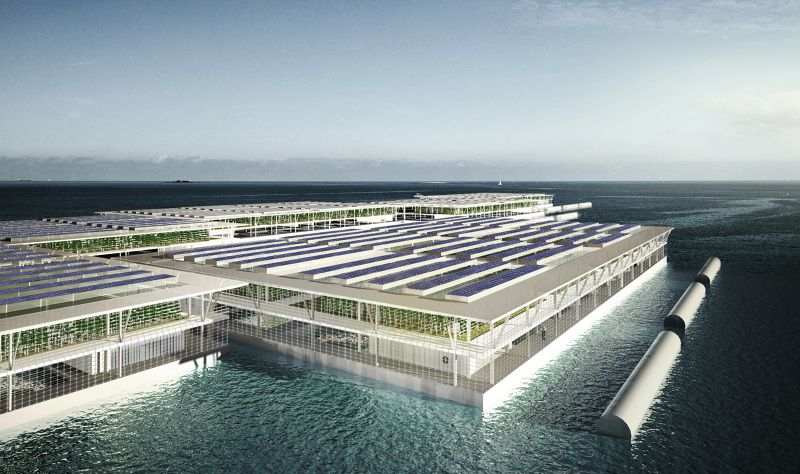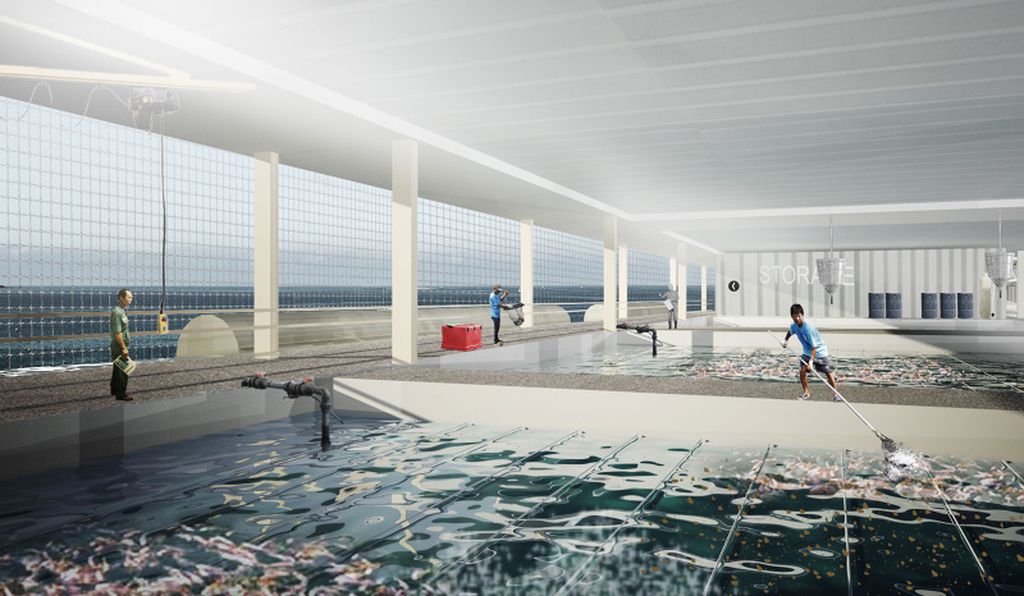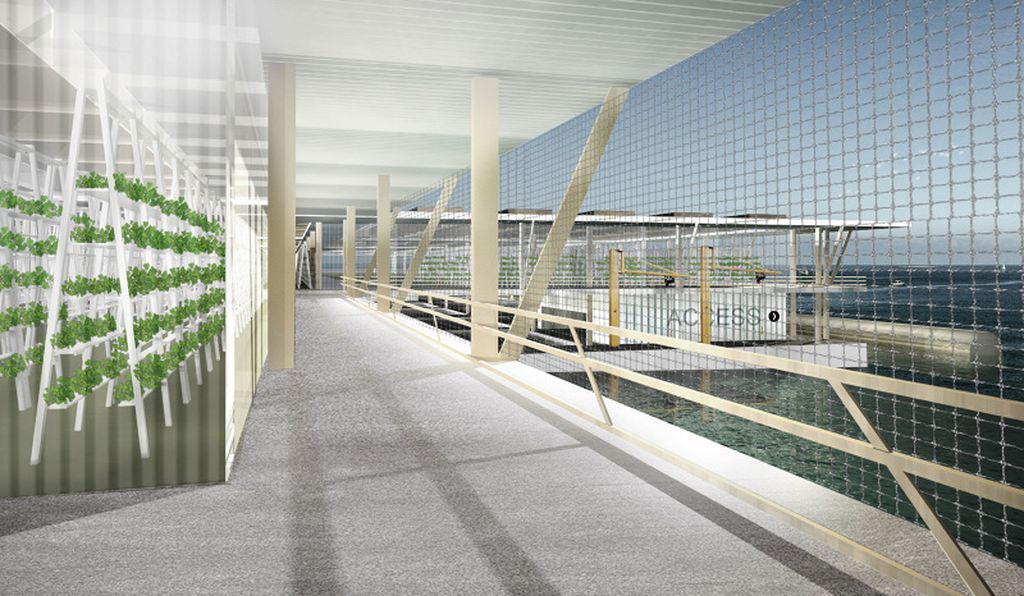Smart Floating Farms
By Fanny Bates
 动小农场
动小农场
近年来,农业创新已经找到了新方法,以促进粮食生产,分析土壤和监测作物的健康。 2012年,世界银行和几个国家在第一届农业,粮食和气候变化全球会议上开始推广气候智能型农业的概念。当农业生产力和收入被气候变化压倒时,其他国家迫切需要了解和实施这些新战略。最困难的情况将发生在亚太地区。根据天气情况,农业可能是最脆弱的部门。现在的世界人口估计为73亿,联合国预测到2030年将达到85亿,到2050年达到97亿。确保粮食和饮用水的充足供应,在30年内我们需要增加70%的产量 。这对全球农业部门来说是一项艰巨的任务。 (全世界数百万人处于饥荒的边缘)。
智能浮动农场的概念
巴塞罗那的研究人员解决了资源和土壤稀缺以及当前气候变化的挑战,在农业领域取得了巨大突破。雄心勃勃的公司Forward Thinking Agriculture提出了未来农场的想法,这些农场可以在海上漂浮。他们将该项目命名为智能浮动农场,将环保概念扩展到极限。 Javier F. Ponce与Jakub Dycha合作,将农场概念化为农业替代品,与传统种植者和农业家一起生产新鲜有机食品。他们希望这个可持续发展的系统能够促使其他社区吃得更健康,并为每个人提供充足食物。该系统有很多层次,在蔬菜,鱼类方面具有很高的生产率,但它不包括红肉或家禽的生产。
养鱼场和水培花园
底层包括养鱼场,完全封闭在户外。它包含几个用于养鱼作业的子单元,例如以网格为基础小单元的网箱,接水点,屠宰场,包装和运输存储。这些精心策划的部分将有助于在未来几年保持稳定的鱼类流动,允许这些群体在屠宰前生长成熟。
最重要的组成部分是自动化的水培花园,它将起到温室的作用,同时还有微气候控制作物种植。它不需要肥沃的土地或农药,相反,农民会使用含有营养的水来滋养和种植植物。这部分也可以堆叠以占用更少的空间。这个想法是生活在土壤贫瘠地区和地区的人们的福音。 该系统能将鱼塘废水提供给各种绿叶蔬菜。反过来,蔬菜废物也可以用于喂养鱼类 目前,该计划的目的是使该结构能够自我维持并有效满足粮食需求。设计者估计,浮动农场每年可生产8,152吨蔬菜和1,703吨鱼。由于各种综合因素,浮动农场可以在一年365天内生产食物,初始投资可以在不到十年的时间内收回。
In recent years, agricultural innovations have addressed promising new ways to boost food production, analyze soil and monitor crop health. In 2012, the World Bank and several countries started promoting the concept of Climate-Smart Agriculture at the first Global Conference on Agriculture, Food, and Climate Change. The urgent need for other countries to be acquainted with the concept and incorporation of these new strategies comes at a time when agricultural productivity and incomes will be overwhelmed by climate change. The most difficult situation is set to be in the Asia-Pacific region which has yet to incorporate these national agricultural strategies.
Agriculture is likely to be the most vulnerable sector that is highly dependent on the weather. Today the world population is estimated to be 7.3 billion and the United Nations has predicted that it will reach 8.5 billion in 2030 and 9.7 billion by 2050. Ensuring adequate supplies of food and drinking water will need to increase by 70% over the next 30 years. This is a daunting task for the global agricultural sector, especially when we consider the effects of climate change and resource scarcity (with millions of people around the world on the brink of famine).

Much of the power needed for the floating farm would come from rooftop solar arrays
Concept of Smart Floating Farm
Addressing the need for resource and soil scarcity and current climate changes, a group of researchers from Barcelona made a huge breakthrough in the agricultural sector. The ambitious company, Forward Thinking Agriculture, has come up with the idea of farms of the future, which will operate autonomously as they float on the open sea. They have named the project Smart Floating Farms, stretching the eco-friendly concepts to the limits. Javier F. Ponce, in collaboration with Jakub Dycha, has conceptualized these farms as a farming alternative which would work with traditional growers and agriculturalists to produce families with fresh, organic food. They hope that this sustainable system will drive other communities to eat healthier and produce food available to everyone. The system has many layers and will be highly productive when it comes to vegetables, fish and solar energy, but it does not include the production of red meat or poultry.
This structure features three main levels. These levels would be broken up by functions, connected together to achieve the full productivity. On the top floor, there are solar panels which will equip the system with enough energy and meet the standard energy needs without using other sources of energy. This will be achieved through skylights and photovoltaic solar cells converting sunlight into energy. Size of a rectangular shaped structure across all areas will be about 2.2 square feet. Space that isn’t for growing crops will be used for walkways and possibly, for other farms to be clustered together to improve their efficiency.

The bottom level would be used for fish farming
Fish Farm and Hydroponic Gardens
Bottom level comprises fish farms and is fully closed to the outdoors. It contains several subunits for fish farming operations, such as cages which are grid-based for efficiency and further split into smaller units, water access points, the slaughterhouse, packaging, and shipping storage. These carefully planned subunits will help to maintain a steady flow of fish for years to come, by allowing the groups to attain maturity before slaughter. The level serves as the support element for the entire floating farm with external wave barriers, protection, processing center and boat docking points.
The most important component would be the automated hydroponic garden which would function as a greenhouse together with microclimate control for crop cultivation. It would not require fertile land or pesticides but instead, the farmers would use nutrient-laden water to nourish and grow plants. This part can be also stacked to take up less space. The idea is a role model for people who live in regions and areas with poor soil. With the aeroponic walls and wastewater from fish ponds, the system will offer various leafy greens and vegetables. In turn, vegetable waste will be used to feed the fish.

Hanging hydroponic gardens would be designed for maximum productivity
These vegetables could be grown in a medium such as clay, coconut or rock wool, etc. In future, wind turbines and wave energy converter systems could also be installed to maintain the system’s efficiency. For now, the plan is for the structure to be self-sustaining and effective in meeting the food needs. The designers estimate that SFF can produce an estimated 8,152 tons of vegetables and 1,703 tons of fish annually. As a result of the various integrated elements, the “SFF” could produce food 365 days in a year and the initial investment could be paid back in less than ten years.